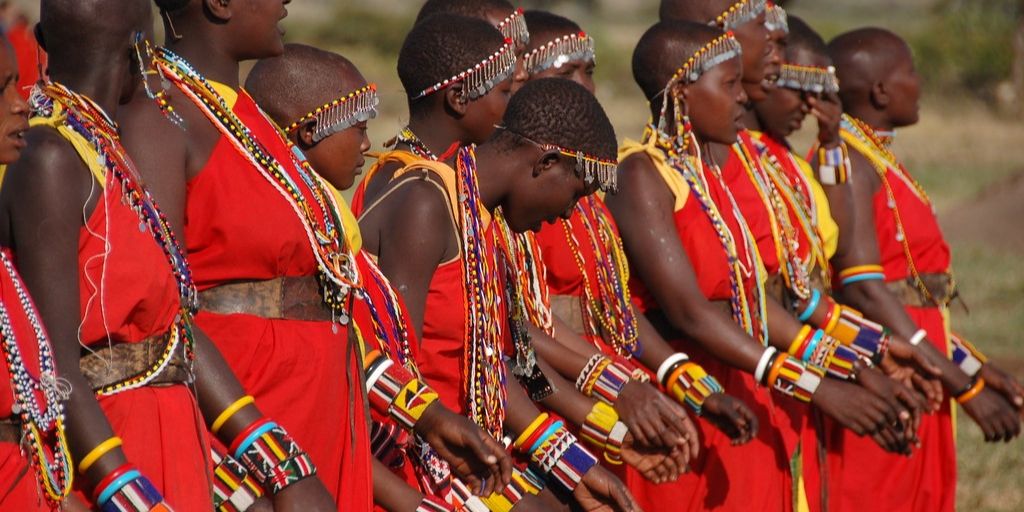The Ngorongoro Conservation Area, lies in the Eastern Great Rift Valley in Tanzania, and is a wildlife hotspot, equal to anywhere in Africa for a safari.
Thousands of animals, including endangered black rhino, blacked-maned lion, leopard, cheetah, warthog, buffalo, flamingo and hippopotamus roam freely in the giant 260 km sq. crater. That’s why an Ngorongoro safari is one of the best for animal spotting. And the reason so many people visit Ngorongoro Conservation Area, which lies in the Eastern Great Rift Valley in Tanzania.
Jump to section: Highlights, Wildlife, Best time to visit, Getting there, Accommodation

View of the Ngorongoro crater from the rim
An Ngorongoro safari game drive will take you up the side of the Ngorongoro Crater rim and then down into the largest unfilled volcanic caldera in the world. The inactive caldera is so massive that it can be seen from space.
Today officials monitor the number of Ngorongoro safari visitors to protect the fragile environment contained in the volcanic bowl. Consequently, you must obtain a permit to enter Ngorongoro Crater and Olduvai Gorge, and a licensed guide is required to accompany you at all times. Your Ngorongoro safari won’t feel overcrowded because the park’s conservation rules dictate that no more than five vehicles can be around an animal or kill at one time.
Although the crater and animals are the main attractions for an Ngorongoro safari, the 8,300-km-sq Ngorongoro Conservation Area spreads out far beyond the volcanic bowl and includes other fascinations.
The Olduvai Gorge, where Louis and Mary Leaky uncovered the remains of the earliest humans, is an attraction in its own right. Don’t miss the Olduvai Visitor Centre to learn more about how this area came to be known as the “Cradle of Mankind.” UNESCO added the designation of Cultural World Heritage Site to Ngorongoro Conservation Area’s list of credentials for its “extraordinary record of human evolution at the site” in 2010.
Ngorongoro safari highlights
A unique microcosm of East African wildlife
The bowl-shaped crater with its steep walls naturally contains over 50 animal species and 500 species of birds. The area is said to hold the densest concentration of wildlife in Africa and is part of the Serengeti ecosystem, which supports spectacular animal migrations.
Since the rim of the East African Rift wall prevents animals from roaming towards the southern and eastern parts of the Ngorongoro Conservation Area, migration routes in and out of the north and west sides of the park are predictable. Your licensed guide and tour operator will know where to take you to see animals depending on when you visit Ngorongoro.
The outstanding biodiversity of this wonderland is one of the reasons that UNESCO designated the Ngorongoro Conservation Area as an International Biosphere Reserve in 1981. Later, Walt Disney Pictures based the migration scenes of their animated movie, The Lion King, on the animal migrations in the nearby Serengeti and Ngorongoro. According to UNESCO, one million wildebeest, 72,000 zebras, and around 350,000 Thompson and Grant gazelles make up the annual exoduses – known as the Great Wildebeest Migration – that move through both the Serengeti and Ngorongoro areas. This migration is one of the most massive animal migrations on earth (see five other amazing African migrations).
The big 5 in Ngorongoro Conservation Area
Ngorongoro Conservation Area is home to the big five African animals:
Buffalo: An estimated 4,000 buffalo, known as Cape buffalo or African buffalo, thrive in the Ngorongoro caldera.
Elephant: Approximately 300 African elephants are protected in the Ngorongoro Conservation Area. In the crater itself, elephants can be observed in Gorigor Swamp and acacia habitats.
Rhinoceros: Approximately 30 rare black rhinos are found in Ngorongoro Crater. The aggressive animals, which fight each other, have the highest rates of mortal combat recorded for any mammal.
Lion: Ngorongoro Crater is home to the densest known population of lion on the planet. With 60 – 70 lions in this relatively small area, chances are good that you will see lion on your Ngorongoro safari. Across the region more broadly, however, lions are being poisoned as they come to conflict with livestock owners.
Leopard: Leopard live in the tree line high up on the crater rims, meaning you would be fortunate to see the shy African leopard during your Ngorongoro safari.
Ngorongoro wildlife beyond the big 5
Besides the big five animals, other safari animals you may well see during a game drive in Ngorongoro are wildebeest (7,000), zebra (4,000), eland (3,000) and Grant’s and Thomson’s gazelles (3,000), as well as healthy populations of hyena and cheetah.
You definitely won’t see giraffes in the crater—it is said that their long legs can’t make it up the steep rim of the caldera. However, you will observe the long-necked creatures outside the basin within the Ngorongoro Conservation Area.


Masai in Ngorongoro
Explore the fascinating culture of the Maasai people—semi-nomadic cattle herders—and other indigenous groups who make their homes in the Ngorongoro Conservation Area.
Maasai bomas inside the park are designated to welcome Ngorongoro safari visitors. A boma is a grouping of small plastered houses, called Enkajijik. A thorn fence surrounds the boma for protection and keeps cattle safe at night. In these designated bomas, you may take photos of the people, talk with them about their culture and buy handcrafted items. Outside these areas, it is not proper to take pictures of the Maasai people.

Masai tribes women dancing
How to get to Ngorongoro Conservation Area
Ngorongoro Conservation Area is part of Tanzania’s northern circuit route for overland safaris. Fly into Kilimanjaro International Airport (JRO), and from there, you can drive or fly to Lake Manyara Airport (LKY) 3h25m/191 km. From Lake Manyara Airport, Ngorongoro Conservation Area is 0h52m/42 km away.
Another option is to fly into Dar es Salaam (DAR) on an international flight and then connect to Arusha (ARK) on a domestic flight. From Arusha, it is a 2h35m/153 km drive to Ngorongoro Conservation Area.
Your tour operator can arrange for charter flights to the Lake Manyara Airport or elsewhere, so check with them for the most appropriate flights. Bear in mind that the conservation area is one of the largest game reserves in Africa, so it could take a long while to drive to your lodge once inside the park.
Best time to visit Ngorongoro Conservation Area
Roads get almost impassable during the rainy season, so its best to take a Ngorongoro safari from June to October when the rains have finished. Temperatures are most cooling during these months. But if you are eager to see the wildebeest migration, in April-May, the wildebeest begin moving north from Ngorongoro.
Ngorongoro safari accommodation
From luxury to rustic, you’ll find plenty of Ngorongoro safari accommodation close to the gates of the conservation area. Within the Ngorongoro Conservation Area, six lodges are perched along the crater rim.
The iconic African safari lodges inside Ngorongoro Conservation Area include:
- Ngorongoro Crater Lodge—the luxurious lodge built in 1939 offers private butlers,
- Ngorongoro Rhino Lodge—the rustic home of Ngorongoro’s first conservationist, was built in 1942,
- Ndutu Lodge—cosy cottages constructed in 1946 provide amenities like campfires at night, and
- Ngorongoro Wildlife Lodge—delivers dramatic views of the caldera from every room, and dates back to 1971.
Newer accommodation built in Ngorongoro Conservation Area during the mid-1990s includes:
- Ngorongoro Sopa Lodge—the swimming pool on the terrace overlooks the crater, and
- Ngorongoro Serena Lodge—uses river rock in its unique and earthy architectural design. Ask for an upper room for the best views of the basin below…if you do not mind climbing stairs.
In addition to the six hotels above, 16 campsite areas are within the boundaries of the Ngorongoro Conservation Area Authority.
If you’re into a rustic experience owned by local people, check out Havennature Safari Camp and Lodge near the town of Karatu outside the Ngorongoro Conservation Area. The lodge and camp make a perfect safari launchpad as it is situated between Tarangire National Park, Lake Manyara National Park, Ngorongoro Conservation Authority Area and Serengeti National Park. The rustic camp provides bush barbeques, campfires and walking safaris within its 20-acre secure, fenced area.
Find Ngorongoro accommodation prices and availability:
Have you been on an Ngorongoro safari and have some tips to share? We’d love to hear from you in the comments section below.
